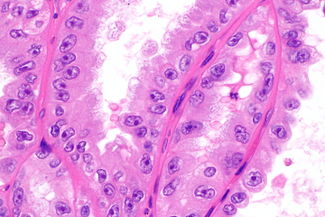Difference between revisions of "Hereditary leiomyomatosis and renal cell carcinoma syndrome"
Jump to navigation
Jump to search

| Line 1: | Line 1: | ||
[[Image:Hereditary leiomyomatosis and renal cell carcinoma associated RCC -- high mag.jpg|thumb| | [[Image:Hereditary leiomyomatosis and renal cell carcinoma associated RCC - TC-like -- very high mag.jpg|thumb|325px|right|[[Hereditary leiomyomatosis and renal cell carcinoma syndrome-associated renal cell carcinoma]] showing the classically described prominent nucleoli with perinucleolar clearing. [[H&E stain]]. (WC/Nephron)]] | ||
'''Hereditary leiomyomatosis and renal cell carcinoma syndrome''' (abbreviated '''HLRCC'''), also '''hereditary leiomyomatosis and renal cell cancer''', is an uncommon syndrome caused by fumarate hydratase (FH) gene mutations.<ref name=omim136850>{{OMIM|136850}}</ref><ref name=omim150800>{{OMIM|150800}}</ref> | '''Hereditary leiomyomatosis and renal cell carcinoma syndrome''' (abbreviated '''HLRCC'''), also '''hereditary leiomyomatosis and renal cell cancer''', is an uncommon syndrome caused by fumarate hydratase (FH) gene mutations.<ref name=omim136850>{{OMIM|136850}}</ref><ref name=omim150800>{{OMIM|150800}}</ref> | ||
Revision as of 05:43, 16 March 2016

Hereditary leiomyomatosis and renal cell carcinoma syndrome-associated renal cell carcinoma showing the classically described prominent nucleoli with perinucleolar clearing. H&E stain. (WC/Nephron)
Hereditary leiomyomatosis and renal cell carcinoma syndrome (abbreviated HLRCC), also hereditary leiomyomatosis and renal cell cancer, is an uncommon syndrome caused by fumarate hydratase (FH) gene mutations.[1][2]
Characteristics:
- Hereditary leiomyomatosis and renal cell carcinoma syndrome-associated renal cell carcinoma.
- Benign leiomyomas skin/uterus.
- Uterine leiomyosarcoma.
General
- Autosomal dominant inheritance[3] with variable penetration.[4]
- In one series of 21 families: 62% renal cancer, 76% had cutaneous leiomyomas and 100% had uterine leiomyomas.[5]
Features - clinical:
- Leiomyomas - high penetrance.
- Hereditary leiomyomatosis and renal cell carcinoma syndrome-associated renal cell carcinoma.
- Often aggressive and significant cause of mortality.[7]
Note:
- The RCC in the past was typically diagnosed as papillary renal cell carcinoma.[8]
See also
References
- ↑ Online 'Mendelian Inheritance in Man' (OMIM) 136850
- ↑ Online 'Mendelian Inheritance in Man' (OMIM) 150800
- ↑ Merino, MJ.; Torres-Cabala, C.; Pinto, P.; Linehan, WM. (Oct 2007). "The morphologic spectrum of kidney tumors in hereditary leiomyomatosis and renal cell carcinoma (HLRCC) syndrome.". Am J Surg Pathol 31 (10): 1578-85. doi:10.1097/PAS.0b013e31804375b8. PMID 17895761.
- ↑ Reyes, C.; Karamurzin, Y.; Frizzell, N.; Garg, K.; Nonaka, D.; Chen, YB.; Soslow, RA. (Jul 2014). "Uterine smooth muscle tumors with features suggesting fumarate hydratase aberration: detailed morphologic analysis and correlation with S-(2-succino)-cysteine immunohistochemistry.". Mod Pathol 27 (7): 1020-7. doi:10.1038/modpathol.2013.215. PMID 24309325.
- ↑ 5.0 5.1 Pithukpakorn, M.; Wei, MH.; Toure, O.; Steinbach, PJ.; Glenn, GM.; Zbar, B.; Linehan, WM.; Toro, JR. (Sep 2006). "Fumarate hydratase enzyme activity in lymphoblastoid cells and fibroblasts of individuals in families with hereditary leiomyomatosis and renal cell cancer.". J Med Genet 43 (9): 755-62. doi:10.1136/jmg.2006.041087. PMID 16597677.
- ↑ Toon, CW.; Hasovits, C.; Paik, J.; Field, M.; Chou, A.; Hugh, TJ.; Pavlakis, N.; Gill, AJ. (Jul 2014). "Skin rash, a kidney mass and a family mystery dating back to World War II.". Med J Aust 201 (1): 58-60. PMID 24999901.
- ↑ Chen, YB.; Brannon, AR.; Toubaji, A.; Dudas, ME.; Won, HH.; Al-Ahmadie, HA.; Fine, SW.; Gopalan, A. et al. (May 2014). "Hereditary leiomyomatosis and renal cell carcinoma syndrome-associated renal cancer: recognition of the syndrome by pathologic features and the utility of detecting aberrant succination by immunohistochemistry.". Am J Surg Pathol 38 (5): 627-37. doi:10.1097/PAS.0000000000000163. PMID 24441663.
- ↑ Humphrey, Peter A; Dehner, Louis P; Pfeifer, John D (2008). The Washington Manual of Surgical Pathology (1st ed.). Lippincott Williams & Wilkins. pp. 290. ISBN 978-0781765275.